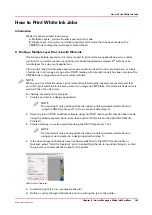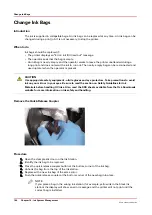
How to Get Good Results With Varnish
Introduction
The application of varnish to a print produces some spectacular, and at times, surprising results
depending on the combination of design and media. To achieve a smooth high gloss, varnish
must be applied in heavy coats. To achieve good results with varnish, consider the following
principles and tools:
•
Maintain a Clean Environment
•
Keep the Printer Clean
•
Prepare the Media Surface
•
Consider Varnish in the Job Design
NOTE
Varnish does not require any special handling but, as with all inks, regular printhead
maintenance is important.
Maintain a Clean Environment
All inkjet printers are prone to image quality / jetting reliability issues when there is airborne dust
or other debris that can interfere with the jetting of ink from the printheads. The air quality within
the room is extremely important to the achievement of printed varnish images with minimal dust
contamination. It is also beneficial for maintaining the overall image quality and printhead jetting
reliability.
In the printer operating environment the amount of airborne particles can influence the final
varnish finish. Since the systems that condition and circulate the air can also circulate dust and
particles, keeping the printer clean enough to produce good gloss varnish finish may require
extra cleaning. If you use the Varnish option frequently, we recommend that you take steps to
minimize contaminants by isolating the printer from dusty conditions.
Some tips for minimizing airborne dust and debris contamination:
• Install a good ventilation system and diligently keep air filters clean.
• Avoid dusty areas – printer should not be located near routers, sanders, trimmers or other
machinery that generate airborne dust and debris.
• Do not install the printer on carpet or untreated concrete floor or other surfaces that can be a
source of dust.
• Avoid placing the printer near air vents.
• Frequently wet-mop the room floor.
Keep the Printer Clean
Since the printer has moving parts (e.g., fans, carriage, gantry etc.) it is important to keep these
parts clean and dust free to minimize the risk of circulating airborne dust and debris and
depositing it on the media. Follow these tips for keeping the printer clean:
• Keep the fan filters clean and replace as needed.
• Wipe the bottom of the carriage clean with a lint free cloth.
• Wipe (with a swab) the cut holes in the carriage pan around the printheads.
• Wipe the external parts of the printer with a damp lint-free cloth: the table, gantry, carriage
etc..
Prepare the Media Surface
Varnish can be successfully applied to most media. However, on some un-coated high-absorbent
media, the varnish can be "lost" to the surface and it will be hard to tell that anything was applied.
How to Get Good Results With Varnish
Chapter 9 - How to Manage a White Ink Workflow
153
Océ Arizona 1200 Series
Summary of Contents for arizona 1240 GT
Page 1: ...User guide Oc Arizona 1200 Series Revision 3010121377...
Page 6: ...Contents 6 Oc Arizona 1200 Series...
Page 7: ...Chapter 1 Introduction...
Page 11: ...Chapter 2 Product Compliance...
Page 15: ...Chapter 3 Safety Information...
Page 34: ...Roll Media Safety Awareness 34 Chapter 3 Safety Information Oc Arizona 1200 Series...
Page 35: ...Chapter 4 How to Navigate the User Interface...
Page 56: ...Software Update Module 56 Chapter 4 How to Navigate the User Interface Oc Arizona 1200 Series...
Page 57: ...Chapter 5 How to Operate Your Oc Arizona Printer...
Page 78: ...Media Registration 78 Chapter 5 How to Operate Your Oc Arizona Printer Oc Arizona 1200 Series...
Page 79: ...Chapter 6 Operating the Oc Arizona 1200 XT...
Page 85: ...Chapter 7 Roll Media Option...
Page 109: ...Chapter 8 Static Suppression Option...
Page 113: ...Chapter 9 How to Manage a White Ink Workflow...
Page 157: ...Chapter 10 Ink System Management...
Page 161: ...Chapter 11 Troubleshooting...
Page 163: ...Chapter 12 Printer Maintenance...
Page 207: ...Appendix A Application Information...
















































